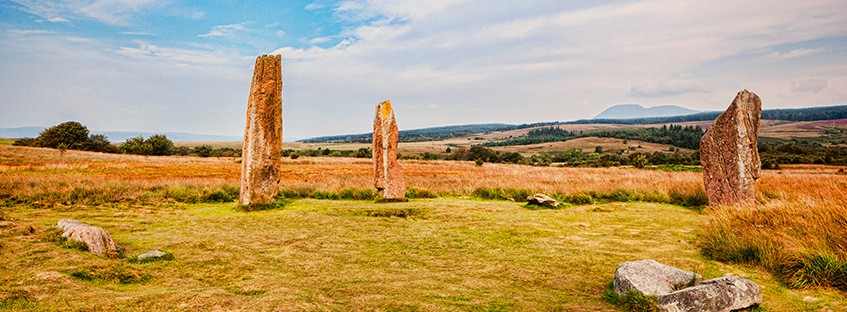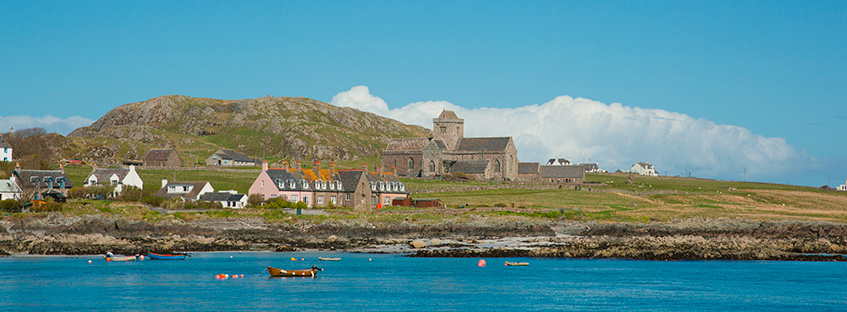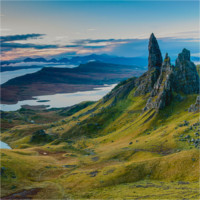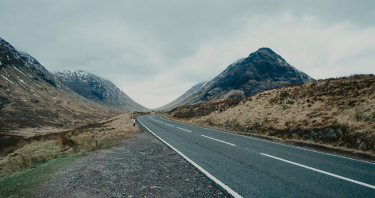Scotland is a country that has almost 12,000 km of coastline, to which must be added about 800 islands, each and every one of them with characteristics that make them unique and special. The climate, its nature and its isolation make its landscapes appear almost untouched, impress and leave on the retina of its visitors an image difficult to forget.
The archipelagos that house the Islands of Scotland
The Inner Hebrides
It is a group of Islands located immediately on the west coast of Scotland, perfectly defined by its white sand beaches and wildlife, many of them like Islay enjoy good and deserved fame thanks to their whiskey.
The outer Hebrides
Known as the West Islands, it is a group of islands that form a straight line from Northeast to Southwest. Its three natural reserves leave no doubt that its natural component is one of the reasons why they stand out. But it is not only nature, but the incredible history and especially the prehistoric remains which demonstrate the special interest of human beings to inhabit these islands from very early times.
Some of its islands appear among the “Top Ten” of the islands of the World of various categories.
- Shetland Islands. It is the northernmost territory of the British Isles, they are a group of islands that combine in perfect harmony their Scottish influence and Scandinavian flavor. The light, thanks to its latitude and the temperate influence of the Gulf Stream, produces some of the most coveted landscapes for photographers. Museums, ruins and nature reserves complete the enormous number of possibilities that this group of islands offers us.
- Orkney Islands. Halfway between the Shetlands and the British mainland, they are a group of islands with spectacular character. With ancient traditions, its history has been evident among its numerous archaeological remains of world recognition, as well as its abundant wildlife that finds a rewarding rest in these lands.
- East coast islands. If in the West the view that we can have of the Atlantic Ocean is a sea dotted with Islands, in the Scottish East the opposite occurs: the islands are very rare, but this summer in island spaces, makes these redoubts are real surprises.
The most important islands of Scotland
1- Isle of Skye, the “Isle of Scotland”
“The Island” is undoubtedly the jewel in the crown in Scotland, it has everything and therefore, is the most accessible. If you want to know more about this island, you can read our post about the Isle of Skye. Plus, you can also visit her on our 3-day trip to the Highlands and Isle of Skye.
2- Isle of Arran and its cheeses

It is the largest island in the entire Clyde Fjord, as well as the seventh in all of Scotland. It is not difficult to understand why it is known as “Scotland in miniature” if we know that everything that Scotland symbolizes: castles, mountains, islands, rivers, lakes, forests, towns, pubs, the Middle Ages, gastronomy, landscapes … it is concentrated on an island 32 km long by 16 km wide. What we are looking for on our trips, we will probably find it in Arran.For lovers of gastronomy and spirits, there are distilleries, but in addition to the Scottish product par excellence, they have products such as Arran cheese, a delicious cheddar that is produced locally, in addition to other varieties such as Arran Blue (Arran blue) or Arran Camembert, all with worldwide and British recognition.
If what we are looking for is to soak up its history, the island offers us, a fan that begins 9,000 years ago, with the famous stone circle of Machrie Moor, passing through the bloody battles against the Vikings that the castles witnessed, as the Lochranza stage, it finally falls into the hands of the McDonald clan.

Now, if what we want to find is a natural redoubt, Arran offers its two faces, we can choose between the mountainous north and the south with almost virgin white sand beaches.
In short, Arran is postulated as one of the most acclaimed islands by visitors, whether they are the Scots themselves or from other countries.
How to get:
One-hour ferry from Rothesay or Claonaig
3- Isle of Lewis, Harris and the tweed
Located in the extreme North West of Scotland, it is the largest island in the Hebrides. It is part of an archipelago known as the “long island”, since it forms a narrow line of islands heading from Northeast to Southwest.
This island is classified as one of the best islands in the world, just behind the paradisiacal islands of Thailand and Madagascar. Although it really is a single island, tradition has always spoken of two: the Isle of Lewis and the Isle of Harris, the latter being a peninsula that falls off the former in the southern part.

Its great attraction lies in the incredible history it has, since the first settlers left their mark on monuments such as the impressive “Callanish Standing Stones”. It is also notable to the influence of the Vikings, who left their cultural legacy in traditional architecture, customs or the same language with Gaelic roots, since even today it is the area where more speakers of this language can be found: around the 50% of its population. Thanks to its completely isolated location, along with its history and Gaelic language, this island has acquired a special charm.
Harris Tweed is a very characteristic type of fabric that gets its name curiously from the river found in the Lowlands, where there is a notable reputation for producing a type of wool fabric, but, nevertheless, of lower quality than the Lewis-Harris.

We can combine visits to its white sand beaches and crystal clear waters, occupied by a wide fauna of birds, seals, dolphins and whales, with the numerous historical monuments, as well as its capital Stornoway, an impressive island capital of Victorian architecture. It is one of the islands best connected to the main Scottish cities and even London. As a tip, if we have any contact on this island and his last name is McLeod, make sure of the name and address, as it has traditionally been the territory of this clan and the vast majority of the inhabitants have this surname.
4- Iona Island and St Columba, the sacred island

All the islands have a characteristic above all, whether they are its landscapes (which are full of peace and tranquility), its extensive wealth (both in fauna and flora), without forgetting history and archeology, so linked to this land . Iona is no exception. On the west coast of Mull we find an island, almost an islet, although it can lead to mistakes, because its size does not embody its character.
It is one of the most unique places in all of Scotland. If we know that it is known as “The cradle of Christianity in Scotland” we will already know in what sense its specialty resides. The origin of its popularity appears when Scotland had not yet received even its own name. Since the 6th century, this small point on the map has already become a focus of religious destiny. At first it was reserved for the most important personalities, to the point that there were Scottish, Irish and even Viking kings who made their last trip to this species of “Holy Land”, which later came to be considered in the great Scottish pilgrimage center.
If we land on the island at the first crossing, we are greeted by a Celtic cross. This type of symbol, formed by the traditional cross and a circle that crosses all its legs, is one of the best known in Scotland: Macleans Cross, which has remained as a witness to the religious past of the island. Beyond are the remains of the abbey that once saw one of Scotland’s holy men, Saint Columbanus, walking within its walls, who converted this space into his redoubt for the diffusion of letters and culture during the so-called Dark Age.

Despite its small size, the island is presented as a great attraction for the curious and lovers of history. In addition, its clear waters and white sand beaches are a place to meet nature in its purest form.
Access to the island is made from the Isle of Mull with a ferry that takes just 4 minutes.
5- Isle of Islay, Queen of the Hebrides

We are still on the Scottish west coast, but this time we are heading to the southern tip of the Hebrides, where one of the largest islands awaits us.
Islay is known as the “Queen of the Hebrides”, for the spectacular nature of its landscapes, for its size, being the seventh largest island in the United Kingdom, for its wildlife, but above all for its Whiskey.
If you are wondering what we can do on this island, the answer is: it depends on what you are looking for. Let’s look at some of their options.
Islay whiskey is one of the most coveted in the world. Along with its characteristic smoky flavor, which makes it unique, its particularity is due, according to the locals, to the brownish water of the island. Its eight distilleries (Ardbeg, Lagavulin, Laphroaig, Bowmore, Caol Ila, Bunnahabhain, Bruichladdich and Kilchoman) will surely provide us with a good variety to choose from.
In addition, it has now become one of the main destinations for bird watching. It is necessary to add its spectacular almost virgin panoramic views and the large number of historical monuments that dot the landscape, delighting those who are passionate about routes, whether it is a bike ride, a car or on foot what we are looking for. Its whiskey, its wildlife and its history, will make this island soak us in its character, its Gaelic culture and its friendly and proud inhabitants. It will hardly leave anyone indifferent
Reaching the island is done by ferry from the town of Kennacraig and takes approximately 2 hours.
6- Orkney Islands, more than 7 millennia of History.

If we move to the northeast we will come across one of the most mysterious and pragmatic archipelagos in all of Scotland, composed of some 70 islands, only 20 of them are currently inhabited, which gives us an idea of the wild character of most of its islands. .
The largest island is presented to visitors as its main island, the “Mainland” island and its capital, Kirkwall, which not only offers us its spectacular monuments but its true wealth lies in the excellent gastronomy. Thanks to the generous sea that surrounds these islands, the fish and shellfish that can be eaten are of exceptional quality.
On the other hand, meats are not far behind: beef, but especially lamb, fed by the green pastures that cover most of the islands.
The exceptional and striking North Ronaldsay sheep from the Northern islands also appears here, which is fed with algae, giving its meat an unmistakable flavor.
With a full stomach, a multitude of landscapes and monuments await us, such as the UNESCO World Heritage Neolithic town of Skara Brae, the stone circles of Mainland or, if we go to the southern islands of the archipelago, no we can miss the military history of Scapa Flow or the hiking trails with the impressive Old Man rock stack, as the most outstanding natural monument.

They don’t really have a single attraction, but are suitable for all types of travelers, from intrepid explorers looking for the most hidden places, photographers of unforgettable landscapes or even divers of culture and folk.
Getting to the Orkney is very easy thanks to the great availability of transportation. It can be done by plane from the airports of Glasgow, Edinburgh, Invernes and Aberdeen, or by ferry from Aberdeen, Northlink Scrabster, Gill’s Bay or Pentland Ferries, among other possibilities.
7- The Shetland Islands, the most Viking Scottish Islands

As in the previous case, it is difficult to understand the uniqueness of a single island without explaining the entire archipelago. Its proximity to the Nordic countries contributes with a particular Nordic essence, which blends with Scottish Celtic culture.
For its landscapes, and knowing that it is the northernmost islands of the British Isles, this latitude gives these islands places and light that make it irresistible for those who look from the other side of a camera lens. It has also served as a source of inspiration for artists, seeking lights as spectacular as the Aurora Boreala.
Its richness and exceptional geology and landscape are evident in the creation of protection figures, such as reserves and natural parks, where in summer its up to 19 hours of light will allow us to enjoy walks along its natural reserves, its virgin beaches or the routes and coastal routes available, from where we can see the wildlife in their environment or the foals of the endogenous race ponies, Shetland. Its fertility in landscapes and geology must necessarily be accompanied by an enviable biodiversity, either from birds, making it one of the preferred destinations for observers of these, be it marine mammals. On to of that, it must be added its historical wealth, with more than six millennia of history, with archaeological records scattered in sites throughout the islands. It is necessary to highlight an era, the Viking period, which left its mark on customs and traditions thanks to the almost six centuries of belonging to the Viking territory.
The main options for reaching the islands are by boat from Aberdeen every day of the week, arriving in Lerwick, or by plane from Aberdeen, Inverness, Edinburgh and Glasgow.
8- Jura Island, the deer island

We travel to the West Coast of Scotland to discover the island that retains the name given by the Vikings themselves, which means “the island of the deer”. The reason for such a nickname is not accidental, since its characteristics include its enormous population of this type of animal, with a figure of around 5,500 specimens compared to just 200 inhabitants.
Despite its proximity to the mainland, it is one of the most untamed and most inaccessible islands of all the Scots. This uniqueness is crystallized in a setting that is highly appreciated by both the most determined hikers and the most confident climbers, who find here a place to test their qualities. The hills called Jura Paps and the unusual whirlpools eddies are some of the most popular natural attractions for visitors.
As it can not be otherwise, this island has a distillery that names its whiskey in the same way as the island. This Single Malt Whiskey, distinguished by its strong flavor, is world famous, compared to its milder mainland brothers.
To get to Jura, there are departures from 7.30am to 6.30pm with a journey of just 30 min by ferry from Askaig.
After knowing these islands, it is clear that it is not necessary to go far and to remote places to find the best landscapes. In addition, in the same fjord of Forth we have two islands that deserve to be reviewed.
9- Inchcolm Island, the lookout of the Forth
It is located so close to Edinburgh that on clear days we can see it from the Scottish capital, since it is just 9 kilometers away. It belongs to a group of no more than 20 islands located in the interior of the Forth Fjord. Of all of them, Inchcolm the one that stands out for its special historical relevance has led her to receive the nickname of the Maiden of Forth.
It is the most extraordinary island that we can find in the fjord. Little puffins or gray seals make the rocky outcrops that surround the island their home.
But if we have to point out something for which it stands out, this is its abbey, which gives its name to the island itself, since it means the “island of Columba”, which constitutes the best-preserved monastic complex in all of Scotland.
The island itself is a mirror of the fjord’s warlike past: from the wars against England during the Middle Ages to the two world wars, which have left their mark on the buildings that surround the island (fortifications, casemates, bunkers, ruins …) .
Spectacular views stand out, such as the one we have over the Forth Bridge, over the fjord of the same name, or even Edinburgh itself.
To access the Inchcolm we have a Ferry from Southqueensferry, which on its normal route in the form of 8 runs both sides of the Forth Bridge. It leaves three times a day, which will allow us to take a tour of the island of at least 90 minutes, being able to return on the last ferry of the day.
10- Bass Rock the bastion of cormorants

Without leaving the fjord, but on the border with the North Sea, there is a “tiny” island that stands off the Scottish coasts with more than 100 meters in height, this impressive rock is the result of great volcanic activity that also gave origin to several of the hills surrounding the Scottish capital.
This unique island is home to the largest cormorant colony in the world. As a consequence of the small size of the rock, it shows a brilliant white color from afar, the result of bird defections. The current tenants do nothing but colonize the space that was once occupied by a monastery removed from the world and dedicated to meditation, which was later replaced by successive fortresses used in various wars. Watching one of the most eye-catching nature shows is easy thanks to cruises on offer from North Berwick. There are several types of services, most of which are from the Scottish Seabirds Center. Getting to North Berwick from Edinburgh is very easy either by road or by train from Waverley Station.

It is indisputable that Scotland has a wide range of islands that dot the landscape of its coast. As a result, we have a wide variety of scenarios, where geography, climate, history and wildlife play a fundamental role in creating some of the best images in the entire country, but within the limited geographical limits that constitute the islands themselves.
The list that precedes these words are just some of the names that may sound in this and other lists, but the reality is that there are a large number of islands that also deserve to be in this list, such as the following:
- Colonsay the jewel of the Hebrides
- Isle of Raasay, nicknamed the Red Deer by the Vikings
- Island of Benbecula, known as the step between the South and the North of Uist.
- Island of Staffa, The island that reminded the houses of the Vikings.
- Isla de Barra, with pristine white beaches, the westernmost inhabited island of all the British.
- Mousa Island
- Isla de May, seal refuge
In conclusion, knowing Scotland and its charms in full also means knowing its islands.


















Previous comments...